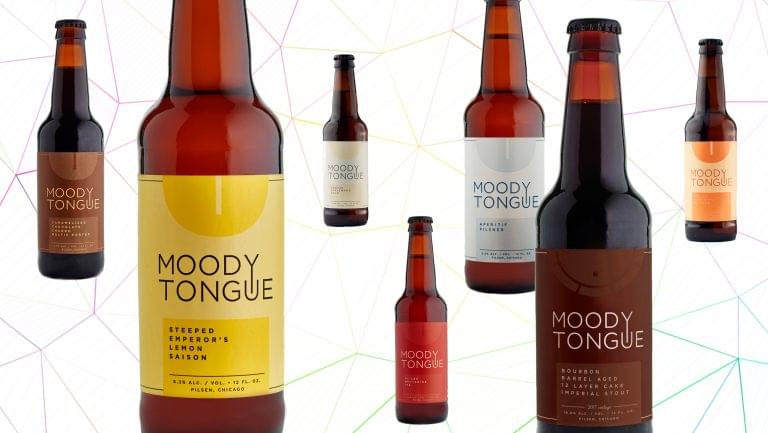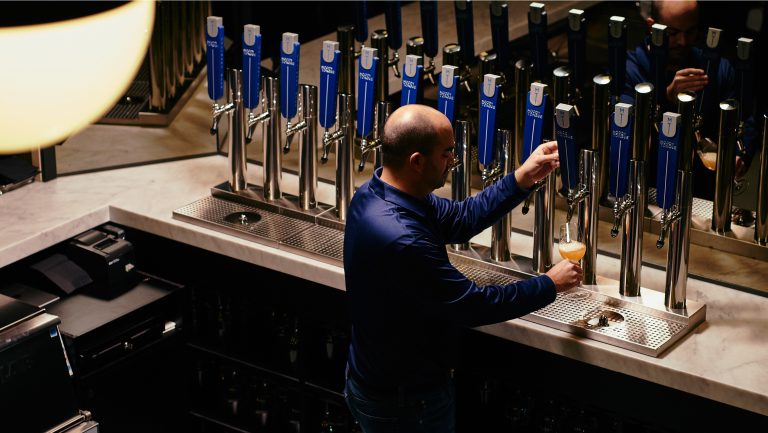When releasing a first beer to market, most brewers avoid brazenness. Screwing up has consequences—the monetary costs of a failed concoction, the rebuke from persnickety reviewers. But Jared Rouben is a notable exception.
When Rouben opened the Moody Tongue Brewing Company in Chicago in 2014, his former employer—the three-Michelin-star restaurant Per Se in New York City—challenged him to brew an unconventional beer for an exclusive dinner. His first beer therefore incorporated a $100-per-ounce ingredient: black truffle. Adding to the challenge, the beer was to be a pilsner, one of the most difficult styles to brew since it requires more cooling and its light profile easily reveals flaws.
But Rouben—who studied at the Culinary Institute of America, cut his teeth at several high-profile restaurants, and served as brewmaster at the Chicago-based Goose Island—finessed a black truffle pilsner. As a classically trained chef, Rouben explained, “I understand taste, flavor, and aromatics. I just now view [those] in a liquid form.”

Don’t miss the latest drinks industry news and insights. Sign up for our award-winning newsletters and get insider intel, resources, and trends delivered to your inbox every week.
Since the release of the pilsner, sales at Moody Tongue have grown by more than 20 percent each year. The brewery, along with its taproom, employs 25 people and distributes across the United States, as well as in Brazil and China.
Rouben doesn’t brew to showcase his flair with pricey ingredients, though—while a four-pack of black truffle beer sells for $120, most other four-packs retail for about $10. His modus operandi is to make quality beer that is as accessible to all drinkers as the food they eat. To achieve this purpose, Rouben abides by a few fundamental truths regarding ingredients, flavor, and language. His ideas are noteworthy, as they challenge much of the conventional wisdom in brewing today.

Brewing with the Seasons
Some brewers order their ingredients from the far corners of the earth, ignoring seasonality. But this chef-turned-brewer rebuffs such practices. To showcase the importance of fresh ingredients, Rouben created the Farmers’ Market Series—a 15.5-gallon weekly release on tap at the brewery. Once spring arrives, Rouben is a fixture at Chicago’s Green City Market, tasting and touching the fruit, learning which farmers take pride in which crops, and snagging the choicest seasonal ingredients for the limited-run beers, which have included Baked Rhubarb Farmhouse Ale, Puréed Raspberry Rice Lager, and Puréed Strawberry IPA.
What Rouben is doing is “next level,” says Abby Schilling, the owner of Mick Klug Farm in nearby St. Joseph, Michigan, and a produce supplier to Moody Tongue. If Rouben were shopping the farmers market as a chef, Schilling notes, he would face one major question: How will this ingredient taste on the plate? But as a brewer, he has to expand that question. “How will the produce taste in the beer?” Schilling says. “And then what should people eat with it?”
In Pursuit of Balance
According to Rouben, beer should enliven the palate, not overwhelm it. Too-tart sours and overly hoppy IPAs baffle him. “What sour wines have you had recently? What sour foods are we consuming?” he asks. “To make a sour right, that’s a skill. That’s an art.” From September to May, Moody Tongue releases a weekly sour. Last year’s selections included a sour cherry lambic, a sour watermelon saison, and a sour peach saison. Each keg is released in the taproom and typically kicked in a few days.

Rouben’s strength is his ability to “take a nontraditional element and apply it to a beer without overwhelming it,” says Keith Lemke, the former vice president of Chicago’s Siebel Institute of Technology, which focuses on beer science and education.
Sours done wrong induce “palate fatigue,” Rouben says, as if he were describing the eleventh plague. The last thing a beer should do is clog one’s taste buds and linger, he says. The experience of drinking beer should be similar to the experience of enjoying a venerated chef’s tasting menu—“You’ve signed up for flavor,” Rouben says, “you’ve achieved it [with a beer], and now you can move on” to the next beer with a ready palate.
Changing the Beer Lexicon
Rouben is convinced that the way the industry talks about beer must change. “What beer and brewing lacks is vocabulary,” he says. While it might seem like a quixotic task to take on, Rouben may be uniquely positioned for it. He teaches food-and-beer pairing for the Cicerone Certification Program and the Siebel Institute, academies that are graduating the next crop of esteemed cicerones and brewers. Rouben is also an examiner for the Master Cicerone certification.
According to Ray Daniels, the founder and director of the Cicerone Certification Program, “Beer people always get into a rut talking about maltiness and hoppiness.” Most consumers don’t understand these descriptions. But food we know; we’ve been eating it all our lives. “Jared is that rare individual who has legitimate chops in both food and beer,” Daniels says. “His real strength is talking about flavor … It’s a really important skill to be able to describe flavors to consumers.”

Rouben is already changing the argot on tours around his 10,000-square-foot brewery and avoiding the usual hackneyed and abstruse brewery-tour language. At Moody Tongue, beer novices can easily learn the process of brewing beer because it’s explained in terms of baking bread and steeping tea. On tours, Rouben equates hopping beers to seasoning food with salt and pepper. He reminds guests that herbs meet a dish at the end of cooking, which is the same logic behind adding aromatics to the kettle toward the end of brewing.
Even Rouben’s beer names are formatted to communicate effectively to both the aware and the oblivious drinker: The first word is the culinary technique, the second defines the flavor or aromatic, and the last denotes the beer style—Sliced Nectarine IPA or Smoked Applewood Gold.
Guests who arrive at the Moody Tongue tasting room might expect an elaborate food menu to complement the beers. But Rouben abides by a couple of simple rules when it comes to comestibles in his brewery. Rule 1: Offer something sweet and something salty. The “something sweet” at Moody Tongue is a 12-layer German chocolate cake with garnishes like graham cracker and pretzel, baked on the premises by a friend from Rouben’s days at culinary school. The “something salty” is briny, fresh-shucked oysters. Additionally, there’s a selection of casual but culinary-minded baguettes—like one with raclette and wine-infused shallot confit—and cheese plates. Rule 2: The beer matters most.

Dispatch
Sign up for our award-winning newsletter
Don’t miss the latest drinks industry news and insights—delivered to your inbox every week.
Noah Lederman has written about beverages for the Chicago Sun-Times, BBC Travel, Beer Advocate, All About Beer, Draft, Beer Necessities, Roads & Kingdoms, and other publications. He writes the blog Somewhere or Bust and is the author of “A World Erased.” Follow him on Twitter.







